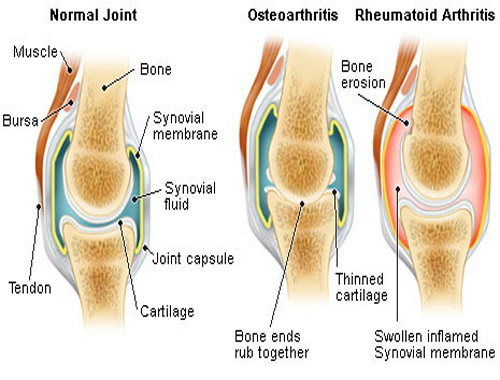Rheumatoid Arthritis

Published: 18 Jun 2025
ICD9: 714.0 ICD10: M06.9 ICD11: FA20
Rheumatoid arthritis (RA) is a chronic inflammatory disorder that can affect more than just your joints.
In some people, the condition also can damage a wide variety of body systems, including the skin, eyes, lungs, heart and blood vessels.
Here's a breakdown of what it is:
![]() Autoimmune Disease: RA is an autoimmune disease, meaning your body's immune system mistakenly attacks its own tissues. In RA, the immune system primarily targets the lining of the joints (the synovium).
Autoimmune Disease: RA is an autoimmune disease, meaning your body's immune system mistakenly attacks its own tissues. In RA, the immune system primarily targets the lining of the joints (the synovium).
![]() Inflammation: This attack causes inflammation, leading to swelling, pain, stiffness, and eventually, joint damage.
Inflammation: This attack causes inflammation, leading to swelling, pain, stiffness, and eventually, joint damage.
![]() Chronic Condition: RA is a chronic disease, meaning it's long-lasting and can have periods of flare-ups (when symptoms are worse) and remissions (when symptoms are milder or absent).
Chronic Condition: RA is a chronic disease, meaning it's long-lasting and can have periods of flare-ups (when symptoms are worse) and remissions (when symptoms are milder or absent).
![]() Joint Involvement: RA typically affects multiple joints, often in a symmetrical pattern (e.g., both hands, both wrists). Small joints in the hands and feet are commonly affected first.
Joint Involvement: RA typically affects multiple joints, often in a symmetrical pattern (e.g., both hands, both wrists). Small joints in the hands and feet are commonly affected first.
![]() Systemic Effects: RA isn't just a joint disease. The inflammation can affect other organs and systems in the body, leading to symptoms like fatigue, fever, weight loss, eye inflammation, lung problems, and heart issues.
Systemic Effects: RA isn't just a joint disease. The inflammation can affect other organs and systems in the body, leading to symptoms like fatigue, fever, weight loss, eye inflammation, lung problems, and heart issues.
![]() Progressive Disease: Without treatment, RA can progressively damage joints, leading to deformities, disability, and a reduced quality of life.
Progressive Disease: Without treatment, RA can progressively damage joints, leading to deformities, disability, and a reduced quality of life.
![]() Cause Unknown: The exact cause of RA isn't fully understood, but it's believed to be a combination of genetic and environmental factors.
Cause Unknown: The exact cause of RA isn't fully understood, but it's believed to be a combination of genetic and environmental factors.
Symptoms of Rheumatoid Arthritis
![]() Joint pain, tenderness, swelling, or stiffness for six weeks or longer
Joint pain, tenderness, swelling, or stiffness for six weeks or longer
![]() Stiffness that is usually worse in the mornings and after inactivity
Stiffness that is usually worse in the mornings and after inactivity
![]() Fatigue
Fatigue
![]() Fever
Fever
![]() Weight loss
Weight loss
Treatment of Rheumatoid Arthritis
There's no cure for rheumatoid arthritis. Treatment focuses on:
![]() Reducing inflammation: Medications such as DMARDs (disease-modifying antirheumatic drugs) and biologics can help suppress the immune system and reduce inflammation.
Reducing inflammation: Medications such as DMARDs (disease-modifying antirheumatic drugs) and biologics can help suppress the immune system and reduce inflammation.
![]() Relieving pain: Pain relievers (analgesics) and NSAIDs (nonsteroidal anti-inflammatory drugs) can help manage pain.
Relieving pain: Pain relievers (analgesics) and NSAIDs (nonsteroidal anti-inflammatory drugs) can help manage pain.
![]() Preventing joint damage: Early and aggressive treatment is crucial to prevent or slow down joint damage.
Preventing joint damage: Early and aggressive treatment is crucial to prevent or slow down joint damage.
![]() Improving function: Physical therapy and occupational therapy can help improve joint function and mobility.
Improving function: Physical therapy and occupational therapy can help improve joint function and mobility.
![]() Lifestyle changes: Exercise, a healthy diet, and stress management can also play a role in managing RA.
Lifestyle changes: Exercise, a healthy diet, and stress management can also play a role in managing RA.
Key Points:
![]() RA is a serious autoimmune disease that affects joints and other body systems.
RA is a serious autoimmune disease that affects joints and other body systems.
![]() Early diagnosis and treatment are important to prevent joint damage and improve quality of life.
Early diagnosis and treatment are important to prevent joint damage and improve quality of life.
![]() Treatment typically involves medications to reduce inflammation and manage symptoms.
Treatment typically involves medications to reduce inflammation and manage symptoms.
If you suspect you have rheumatoid arthritis, it's crucial to see a doctor, preferably a rheumatologist (a doctor specializing in joint diseases), for diagnosis and treatment.